Atten Babler Dairy FX Indices – Mar ’17
The Atten Babler Commodities Dairy Foreign Exchange (FX) Indices finished lower throughout Feb ’17. The USD/Domestic Dairy Importer FX Index declined the most throughout the month, followed by the USD/Dairy Importer FX Index and the USD/ Dairy Exporter FX Index.
Global Dairy Net Trade:
Major net dairy exporters are led by New Zealand, followed by the EU-28, the U.S., Australia and Argentina (represented in green in the chart below). Major net dairy importers are led by China, followed by Russia, Mexico, Japan, Indonesia, Algeria and the Philippines (represented in red in the chart below).
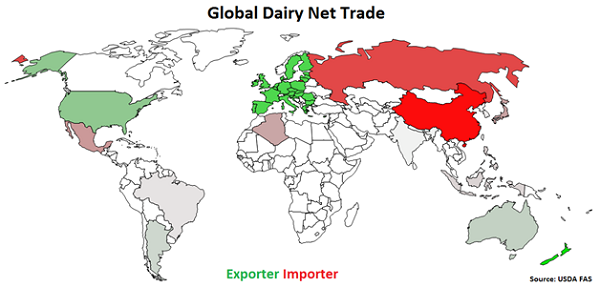 New Zealand accounts for over two fifths of the USD/Dairy Exporter FX Index, followed by the EU-28 at 29% and the United States at 17%. Australia and Argentina each account for between 5-10% of the index.
New Zealand accounts for over two fifths of the USD/Dairy Exporter FX Index, followed by the EU-28 at 29% and the United States at 17%. Australia and Argentina each account for between 5-10% of the index.
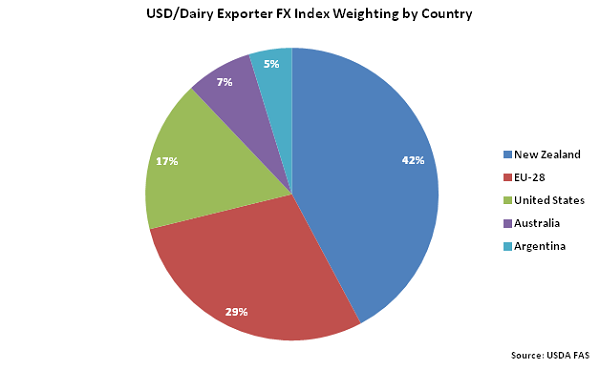 China accounts for a quarter of the USD/Dairy Importer FX Index while Russia accounts for a fifth. Mexico, Japan, Indonesia, Algeria and the Philippines each account for between 5-10% of the index.
China accounts for a quarter of the USD/Dairy Importer FX Index while Russia accounts for a fifth. Mexico, Japan, Indonesia, Algeria and the Philippines each account for between 5-10% of the index.
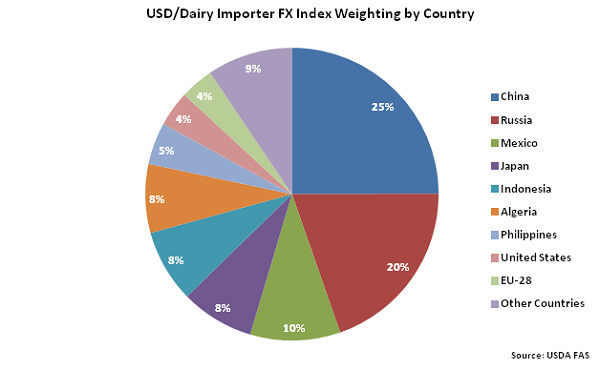 USD/Dairy Exporter FX Index:
The USD/Dairy Exporter FX Index declined 2.2 points during Feb ’17, finishing at a three month low value of 55.1. Despite recent declines, the USD/Dairy Exporter FX Index remains up 4.9 points throughout the past six months and 55.0 points since the beginning of 2014. A strong USD/Dairy Exporter FX Index reduces the competitiveness of U.S. dairy products relative to other exporting regions (represented in green in the Global Dairy Net Trade chart), ultimately resulting in less foreign demand for U.S. products, all other factors being equal. USD appreciation against the Argentine peso has accounted for the majority of the gains since the beginning of 2014.
USD/Dairy Exporter FX Index:
The USD/Dairy Exporter FX Index declined 2.2 points during Feb ’17, finishing at a three month low value of 55.1. Despite recent declines, the USD/Dairy Exporter FX Index remains up 4.9 points throughout the past six months and 55.0 points since the beginning of 2014. A strong USD/Dairy Exporter FX Index reduces the competitiveness of U.S. dairy products relative to other exporting regions (represented in green in the Global Dairy Net Trade chart), ultimately resulting in less foreign demand for U.S. products, all other factors being equal. USD appreciation against the Argentine peso has accounted for the majority of the gains since the beginning of 2014.
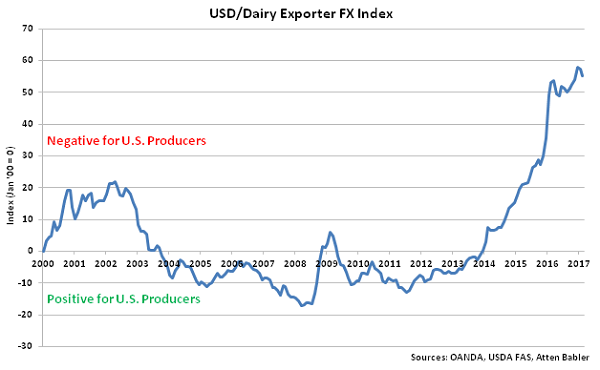 Appreciation against the USD within the USD/Dairy Exporter FX Index during Feb ’17 was led by gains by the Argentine peso, followed by gains by the New Zealand dollar, Australian dollar and euro.
Appreciation against the USD within the USD/Dairy Exporter FX Index during Feb ’17 was led by gains by the Argentine peso, followed by gains by the New Zealand dollar, Australian dollar and euro.
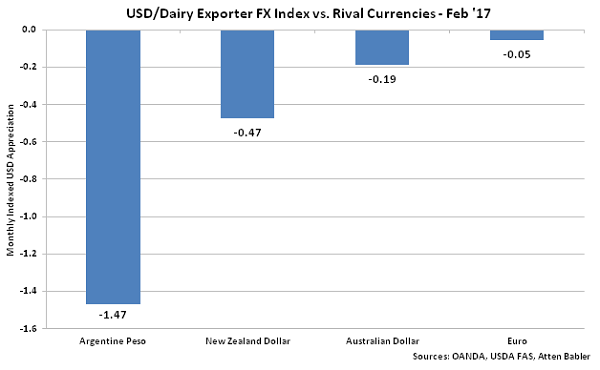 USD/Dairy Importer FX Index:
The USD/Dairy Importer FX Index declined 2.7 points during Feb ’17, finishing at a four month low value of 40.1. The USD/Dairy Importer FX Index has declined 0.5 points throughout the past six months but remains up 36.6 points since the beginning of 2014. A strong USD/Dairy Importer FX Index results in less purchasing power for major dairy importing countries (represented in red in the Global Dairy Net Trade chart), making U.S. dairy products more expensive to import. USD appreciation against the Russian ruble and Mexican peso has accounted for the majority of the gains since the beginning of 2014.
USD/Dairy Importer FX Index:
The USD/Dairy Importer FX Index declined 2.7 points during Feb ’17, finishing at a four month low value of 40.1. The USD/Dairy Importer FX Index has declined 0.5 points throughout the past six months but remains up 36.6 points since the beginning of 2014. A strong USD/Dairy Importer FX Index results in less purchasing power for major dairy importing countries (represented in red in the Global Dairy Net Trade chart), making U.S. dairy products more expensive to import. USD appreciation against the Russian ruble and Mexican peso has accounted for the majority of the gains since the beginning of 2014.
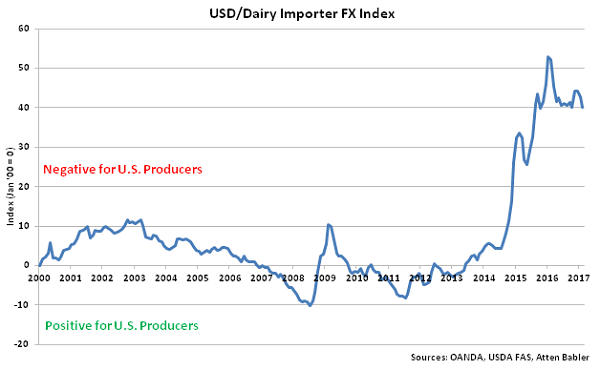 Appreciation against the USD within the USD/Dairy Importer FX Index during Feb ’17 was led by gains by the Mexican peso, followed by gains by the Russian ruble, Brazilian real, Japanese yen and South Korean won.
Appreciation against the USD within the USD/Dairy Importer FX Index during Feb ’17 was led by gains by the Mexican peso, followed by gains by the Russian ruble, Brazilian real, Japanese yen and South Korean won.
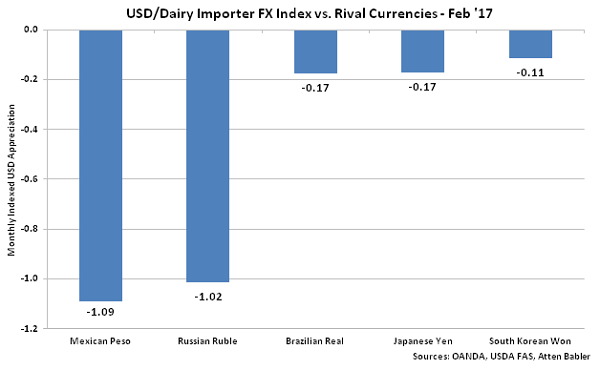 U.S. Dairy Export Destinations:
Major destinations for U.S. dairy exports are led by Mexico, followed by China, Canada, the Philippines, Indonesia, Japan and South Korea.
U.S. Dairy Export Destinations:
Major destinations for U.S. dairy exports are led by Mexico, followed by China, Canada, the Philippines, Indonesia, Japan and South Korea.
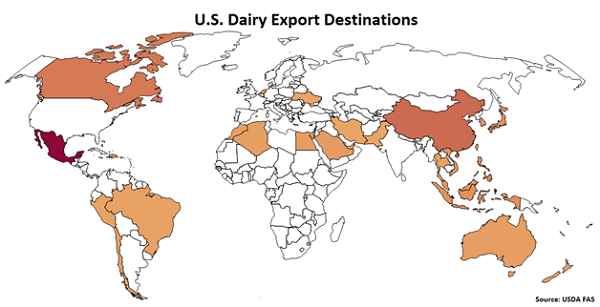 Mexico accounts for nearly a quarter of the USD/Domestic Dairy Importer FX Index, followed by China at 12%. Canada, the Philippines, Indonesia, Japan and South Korea each account for between 5-10% of the index.
Mexico accounts for nearly a quarter of the USD/Domestic Dairy Importer FX Index, followed by China at 12%. Canada, the Philippines, Indonesia, Japan and South Korea each account for between 5-10% of the index.
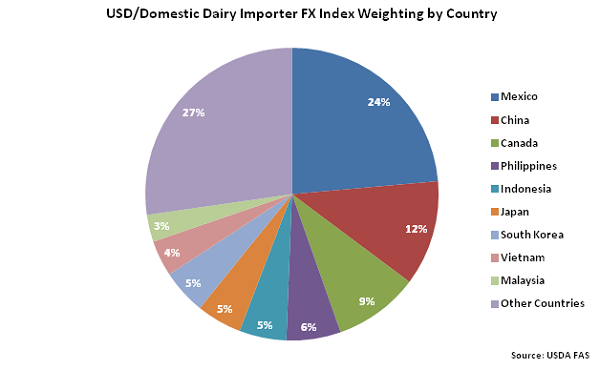 USD/Domestic Dairy Importer FX Index:
The USD/Domestic Dairy Importer FX Index declined 4.1 points from the previous month’s record high during Feb ’17, finishing at a three month low value of 60.1. Despite the decline, the USD/Domestic Dairy Importer FX Index remains up 13.7 points throughout the past six months and 40.3 points since the beginning of 2014. A strong USD/Domestic Dairy Importer FX Index results in less purchasing power for the traditional buyers of U.S. dairy products (represented in red in the U.S. Dairy Export Destinations chart), ultimately resulting in less foreign demand for U.S. products, all other factors being equal. USD appreciation against the Mexican peso and Egyptian pound has accounted for the majority of the gains since the beginning of 2014.
USD/Domestic Dairy Importer FX Index:
The USD/Domestic Dairy Importer FX Index declined 4.1 points from the previous month’s record high during Feb ’17, finishing at a three month low value of 60.1. Despite the decline, the USD/Domestic Dairy Importer FX Index remains up 13.7 points throughout the past six months and 40.3 points since the beginning of 2014. A strong USD/Domestic Dairy Importer FX Index results in less purchasing power for the traditional buyers of U.S. dairy products (represented in red in the U.S. Dairy Export Destinations chart), ultimately resulting in less foreign demand for U.S. products, all other factors being equal. USD appreciation against the Mexican peso and Egyptian pound has accounted for the majority of the gains since the beginning of 2014.
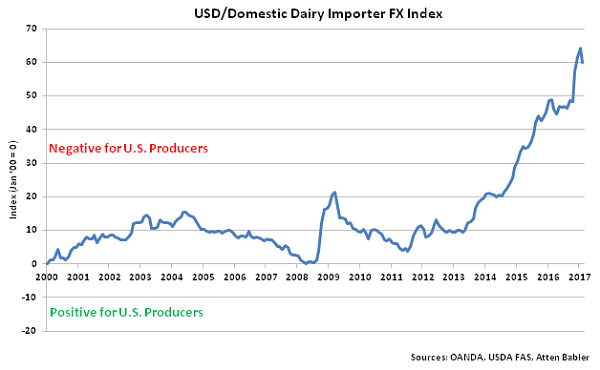 Appreciation against the USD within the USD/Domestic Dairy Importer FX Index during Feb ’17 was led by gains by the Mexican peso, followed by gains by the Egyptian pound, South Korean won and Japanese yen. USD gains were exhibited against the Iranian rial.
Appreciation against the USD within the USD/Domestic Dairy Importer FX Index during Feb ’17 was led by gains by the Mexican peso, followed by gains by the Egyptian pound, South Korean won and Japanese yen. USD gains were exhibited against the Iranian rial.
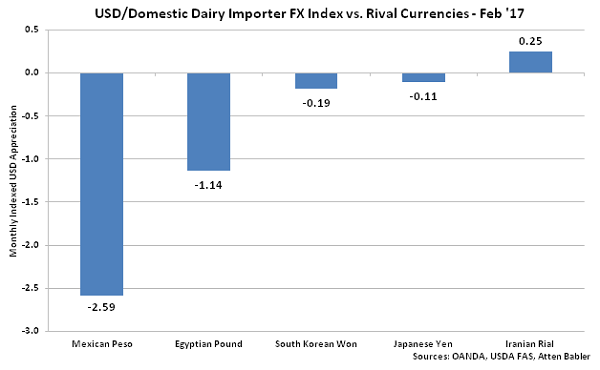
 New Zealand accounts for over two fifths of the USD/Dairy Exporter FX Index, followed by the EU-28 at 29% and the United States at 17%. Australia and Argentina each account for between 5-10% of the index.
New Zealand accounts for over two fifths of the USD/Dairy Exporter FX Index, followed by the EU-28 at 29% and the United States at 17%. Australia and Argentina each account for between 5-10% of the index.
 China accounts for a quarter of the USD/Dairy Importer FX Index while Russia accounts for a fifth. Mexico, Japan, Indonesia, Algeria and the Philippines each account for between 5-10% of the index.
China accounts for a quarter of the USD/Dairy Importer FX Index while Russia accounts for a fifth. Mexico, Japan, Indonesia, Algeria and the Philippines each account for between 5-10% of the index.
 USD/Dairy Exporter FX Index:
The USD/Dairy Exporter FX Index declined 2.2 points during Feb ’17, finishing at a three month low value of 55.1. Despite recent declines, the USD/Dairy Exporter FX Index remains up 4.9 points throughout the past six months and 55.0 points since the beginning of 2014. A strong USD/Dairy Exporter FX Index reduces the competitiveness of U.S. dairy products relative to other exporting regions (represented in green in the Global Dairy Net Trade chart), ultimately resulting in less foreign demand for U.S. products, all other factors being equal. USD appreciation against the Argentine peso has accounted for the majority of the gains since the beginning of 2014.
USD/Dairy Exporter FX Index:
The USD/Dairy Exporter FX Index declined 2.2 points during Feb ’17, finishing at a three month low value of 55.1. Despite recent declines, the USD/Dairy Exporter FX Index remains up 4.9 points throughout the past six months and 55.0 points since the beginning of 2014. A strong USD/Dairy Exporter FX Index reduces the competitiveness of U.S. dairy products relative to other exporting regions (represented in green in the Global Dairy Net Trade chart), ultimately resulting in less foreign demand for U.S. products, all other factors being equal. USD appreciation against the Argentine peso has accounted for the majority of the gains since the beginning of 2014.
 Appreciation against the USD within the USD/Dairy Exporter FX Index during Feb ’17 was led by gains by the Argentine peso, followed by gains by the New Zealand dollar, Australian dollar and euro.
Appreciation against the USD within the USD/Dairy Exporter FX Index during Feb ’17 was led by gains by the Argentine peso, followed by gains by the New Zealand dollar, Australian dollar and euro.
 USD/Dairy Importer FX Index:
The USD/Dairy Importer FX Index declined 2.7 points during Feb ’17, finishing at a four month low value of 40.1. The USD/Dairy Importer FX Index has declined 0.5 points throughout the past six months but remains up 36.6 points since the beginning of 2014. A strong USD/Dairy Importer FX Index results in less purchasing power for major dairy importing countries (represented in red in the Global Dairy Net Trade chart), making U.S. dairy products more expensive to import. USD appreciation against the Russian ruble and Mexican peso has accounted for the majority of the gains since the beginning of 2014.
USD/Dairy Importer FX Index:
The USD/Dairy Importer FX Index declined 2.7 points during Feb ’17, finishing at a four month low value of 40.1. The USD/Dairy Importer FX Index has declined 0.5 points throughout the past six months but remains up 36.6 points since the beginning of 2014. A strong USD/Dairy Importer FX Index results in less purchasing power for major dairy importing countries (represented in red in the Global Dairy Net Trade chart), making U.S. dairy products more expensive to import. USD appreciation against the Russian ruble and Mexican peso has accounted for the majority of the gains since the beginning of 2014.
 Appreciation against the USD within the USD/Dairy Importer FX Index during Feb ’17 was led by gains by the Mexican peso, followed by gains by the Russian ruble, Brazilian real, Japanese yen and South Korean won.
Appreciation against the USD within the USD/Dairy Importer FX Index during Feb ’17 was led by gains by the Mexican peso, followed by gains by the Russian ruble, Brazilian real, Japanese yen and South Korean won.
 U.S. Dairy Export Destinations:
Major destinations for U.S. dairy exports are led by Mexico, followed by China, Canada, the Philippines, Indonesia, Japan and South Korea.
U.S. Dairy Export Destinations:
Major destinations for U.S. dairy exports are led by Mexico, followed by China, Canada, the Philippines, Indonesia, Japan and South Korea.
 Mexico accounts for nearly a quarter of the USD/Domestic Dairy Importer FX Index, followed by China at 12%. Canada, the Philippines, Indonesia, Japan and South Korea each account for between 5-10% of the index.
Mexico accounts for nearly a quarter of the USD/Domestic Dairy Importer FX Index, followed by China at 12%. Canada, the Philippines, Indonesia, Japan and South Korea each account for between 5-10% of the index.
 USD/Domestic Dairy Importer FX Index:
The USD/Domestic Dairy Importer FX Index declined 4.1 points from the previous month’s record high during Feb ’17, finishing at a three month low value of 60.1. Despite the decline, the USD/Domestic Dairy Importer FX Index remains up 13.7 points throughout the past six months and 40.3 points since the beginning of 2014. A strong USD/Domestic Dairy Importer FX Index results in less purchasing power for the traditional buyers of U.S. dairy products (represented in red in the U.S. Dairy Export Destinations chart), ultimately resulting in less foreign demand for U.S. products, all other factors being equal. USD appreciation against the Mexican peso and Egyptian pound has accounted for the majority of the gains since the beginning of 2014.
USD/Domestic Dairy Importer FX Index:
The USD/Domestic Dairy Importer FX Index declined 4.1 points from the previous month’s record high during Feb ’17, finishing at a three month low value of 60.1. Despite the decline, the USD/Domestic Dairy Importer FX Index remains up 13.7 points throughout the past six months and 40.3 points since the beginning of 2014. A strong USD/Domestic Dairy Importer FX Index results in less purchasing power for the traditional buyers of U.S. dairy products (represented in red in the U.S. Dairy Export Destinations chart), ultimately resulting in less foreign demand for U.S. products, all other factors being equal. USD appreciation against the Mexican peso and Egyptian pound has accounted for the majority of the gains since the beginning of 2014.
 Appreciation against the USD within the USD/Domestic Dairy Importer FX Index during Feb ’17 was led by gains by the Mexican peso, followed by gains by the Egyptian pound, South Korean won and Japanese yen. USD gains were exhibited against the Iranian rial.
Appreciation against the USD within the USD/Domestic Dairy Importer FX Index during Feb ’17 was led by gains by the Mexican peso, followed by gains by the Egyptian pound, South Korean won and Japanese yen. USD gains were exhibited against the Iranian rial.
